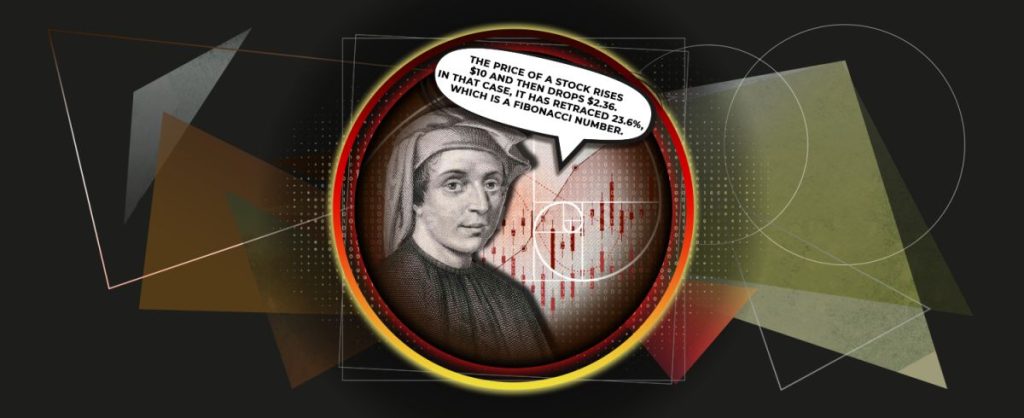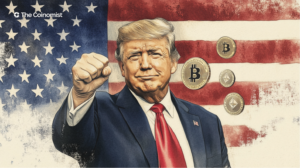Fibonacci levels. Theory and application in trading

Proper use of Fibonacci levels allows the trader to pre-determine possible price reversal points.
Fibonacci levels are a tool that is widely used in the cryptocurrency market to determine support and resistance levels.
The asset price movement occurs according to the “wave theory,” which we had already analyzed in our article. According to this theory states, price action can be broken down into waves that connect highs to lows. Waves have a rather complex structure, so it is often quite challenging to determine the moments of the beginning and end of a trend. Fibonacci levels make this task easier for the trader and help to identify potential price reversal points.
The sequence of numbers known as the Fibonacci numbers (0, 1, 1, 2, 3, 5, 8, 13, 21, 34, 55, etc.) has several features:
1. Each subsequent number is equal to the sum of the two previous ones (0+1=1, 1+1=2, 1+2=3, 2+3=5, 3+5=8, etc.);
2. The ratio of two adjacent numbers is approximately the same. The ratio of the largest to the smallest is 1.618, and the ratio of the smallest to the largest is 0.618);
3. The ratio of numbers that are one number apart (for example, 5 and 13) is approximately 0.382;
4. The ratio of numbers that are two apart (for example, 5 and 21) is approximately 0.236.
Waves with this size ratio divide the price movement of the asset chart. They became the basis for the Fibonacci theory levels and are used to analyze and predict further movement.
The Fibonacci grid consists of horizontal lines. The upper and lower lines are designated as 0 and 1. Between them, there are correction levels located at a distance from the extreme lines to the previously noted proportions – 0.786, 0.618, 0.5, 0.382, and 0.236. It is believed that the “strongest” support or resistance is the 0.618 level.
How to use Fibonacci levels in practice?
Today, almost every trading platform provides the function of independent grid construction. In this case, the user only needs to correctly determine the direction of the trend and the vector of local movement.
By correctly stretching the grid on the price chart, a trader may notice that the waves find resistance when rising or support when falling in the area of Fibonacci lines. It means that the key Fibonacci levels can serve as price reversal points, which allows you to predict the behavior of the asset in the future.
Often the correction of the first two waves reaches 0.618 and 0.786 of the Fibonacci retracement, and the three wave correction usually does not exceed 0.382. With this in mind, a trader can determine the entry and exit points of the market in advance, as well as draw up a more effective risk management plan.
There are two simple trading strategies using Fibonacci levels.
1. Entering a trade when approaching the Fibonacci level. By stretching the Fibonacci grid, as in the screenshot below, we see that the 0.5 level has worked its role of resistance twice. In this case, it made sense to go short around the 0.5 mark with a stop loss slightly above it.
2. Enter the trade when the Fibonacci level is broken. If the level does not provide support or resistance to the price, this may serve as a signal to continue moving in the same direction. In the screenshot below, we see that after the price of BTC broke through the support at the 0.236 ratio, the coin continued to fall. In this case, you can open a short position around 0.236, setting a stop loss just above this mark.
Fibonacci grid on the Bitcoin chart. Source: tradingview
How to build a Fibonacci grid yourself?
In the traditional stock market, closing and opening prices are often used to build the grid. In this case, the trader who creates the grid uses the local lows and highs of the coin. On a downtrend, the grid is stretched from top to bottom; on a growing trend, from bottom to top. This method is not suitable for the cryptocurrency market.
Let's take another look at the chart. We see a downtrend that began at point A and ended at point B, where a local price correction began. We stretch the grid from the peak at point A to the minimum at point B.
As already mentioned, during a downtrend, we stretch the grid from the maximum point to the minimum – from point A to point B.
It should be noted that this analysis tool is used only in the presence of a clearly defined trend. Using Fibonacci levels for an asset that has been consolidating inside a flat for a long time will give false signals. In addition, as with any other analysis tool, it is always better to look for signal confirmations on other indicators before entering a trade.
The content on The Coinomist is for informational purposes only and should not be interpreted as financial advice. While we strive to provide accurate and up-to-date information, we do not guarantee the accuracy, completeness, or reliability of any content. Neither we accept liability for any errors or omissions in the information provided or for any financial losses incurred as a result of relying on this information. Actions based on this content are at your own risk. Always do your own research and consult a professional. See our Terms, Privacy Policy, and Disclaimers for more details.


























